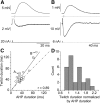Adult mouse motor units develop almost all of their force in the subprimary range: a new all-or-none strategy for force recruitment?
- PMID: 22016552
- PMCID: PMC3210508
- DOI: 10.1523/JNEUROSCI.2893-11.2011
Adult mouse motor units develop almost all of their force in the subprimary range: a new all-or-none strategy for force recruitment?
Abstract
Classical studies of the mammalian neuromuscular system have shown an impressive adaptation match between the intrinsic properties of motoneurons and the contractile properties of their motor units. In these studies, the rate at which motoneurons start to fire repetitively corresponds to the rate at which individual twitches start to sum, and the firing rate increases linearly with the amount of excitation ("primary range") up to the point where the motor unit develops its maximal force. This allows for the gradation of the force produced by a motor unit by rate modulation. In adult mouse motoneurons, however, we recently described a regime of firing ("subprimary range") that appears at lower excitation than what is required for the primary range, a finding that might challenge the classical conception. To investigate the force production of mouse motor units, we simultaneously recorded, for the first time, the motoneuron discharge elicited by intracellular ramps of current and the force developed by its motor unit. We showed that the motor unit developed nearly its maximal force during the subprimary range. This was found to be the case regardless of the input resistance of the motoneuron, the contraction speed, or the tetanic force of the motor unit. Our work suggests that force modulation in small mammals mainly relies on the number of motor units that are recruited rather than on rate modulation of individual motor units.
Figures






Similar articles
-
Recruitment of triceps surae motor units in the decerebrate cat. II. Heterogeneity among soleus motor units.J Neurophysiol. 1996 May;75(5):2005-16. doi: 10.1152/jn.1996.75.5.2005. J Neurophysiol. 1996. PMID: 8734599
-
The Subprimary Range of Firing Is Present in Both Cat and Mouse Spinal Motoneurons and Its Relationship to Force Development Is Similar for the Two Species.J Neurosci. 2018 Nov 7;38(45):9741-9753. doi: 10.1523/JNEUROSCI.2898-17.2018. Epub 2018 Sep 24. J Neurosci. 2018. PMID: 30249797 Free PMC article.
-
Activation of type-identified motor units during centrally evoked contractions in the cat medial gastrocnemius muscle. II. Motoneuron firing-rate modulation.J Neurophysiol. 1996 Jan;75(1):38-50. doi: 10.1152/jn.1996.75.1.38. J Neurophysiol. 1996. PMID: 8822540
-
The resilience of the size principle in the organization of motor unit properties in normal and reinnervated adult skeletal muscles.Can J Physiol Pharmacol. 2004 Aug-Sep;82(8-9):645-61. doi: 10.1139/y04-081. Can J Physiol Pharmacol. 2004. PMID: 15523522 Review.
-
Principles of force gradation in skeletal muscles.Neural Plast. 2003;10(1-2):69-76. doi: 10.1155/NP.2003.69. Neural Plast. 2003. PMID: 14640309 Free PMC article. Review.
Cited by
-
Adult spinal motoneurones are not hyperexcitable in a mouse model of inherited amyotrophic lateral sclerosis.J Physiol. 2014 Apr 1;592(7):1687-703. doi: 10.1113/jphysiol.2013.265843. Epub 2014 Jan 20. J Physiol. 2014. PMID: 24445319 Free PMC article.
-
Time Course of Alterations in Adult Spinal Motoneuron Properties in the SOD1(G93A) Mouse Model of ALS.eNeuro. 2021 Mar 22;8(2):ENEURO.0378-20.2021. doi: 10.1523/ENEURO.0378-20.2021. Print 2021 Mar-Apr. eNeuro. 2021. PMID: 33632815 Free PMC article.
-
From Physiological Properties to Selective Vulnerability of Motor Units in Amyotrophic Lateral Sclerosis.Adv Neurobiol. 2022;28:375-394. doi: 10.1007/978-3-031-07167-6_15. Adv Neurobiol. 2022. PMID: 36066833
-
Respiration-related discharge of hyoglossus muscle motor units in the rat.J Neurophysiol. 2014 Jan;111(2):361-8. doi: 10.1152/jn.00670.2013. Epub 2013 Oct 16. J Neurophysiol. 2014. PMID: 24133219 Free PMC article.
-
Linking Motoneuron PIC Location to Motor Function in Closed-Loop Motor Unit System Including Afferent Feedback: A Computational Investigation.eNeuro. 2020 Apr 27;7(2):ENEURO.0014-20.2020. doi: 10.1523/ENEURO.0014-20.2020. Print 2020 Mar/Apr. eNeuro. 2020. PMID: 32269036 Free PMC article.
References
-
- Alstermark B, Ogawa J. In vivo recordings of bulbospinal excitation in adult mouse forelimb motoneurons. J Neurophysiol. 2004;92:1958–1962. - PubMed
-
- Bakels R, Kernell D. Average but not continuous speed match between motoneurons and muscle units of rat tibialis anterior. J Neurophysiol. 1993b;70:1300–1306. - PubMed
-
- Bennett DJ, Li Y, Siu M. Plateau potentials in sacrocaudal motoneurons of chronic spinal rats, recorded in vitro. J Neurophysiol. 2001;86:1955–1971. - PubMed
-
- Burke R. Handbook of physiology: the nervous system motor control. Bethesda, MD: American Physiological Society; 1981. Motor units: anatomy, physiology, and functional organization; pp. 345–421.
Publication types
MeSH terms
Grants and funding
LinkOut - more resources
Full Text Sources
